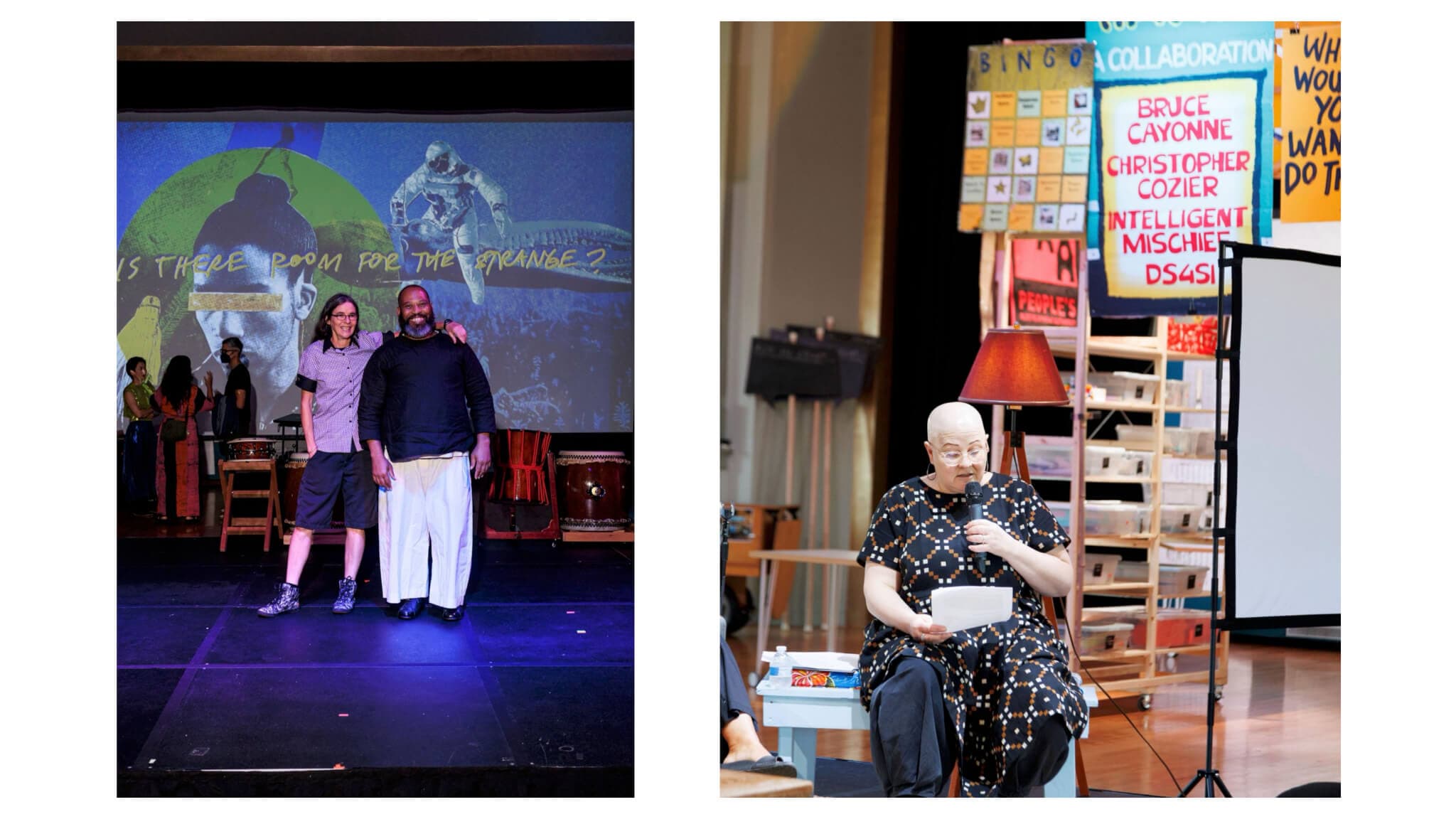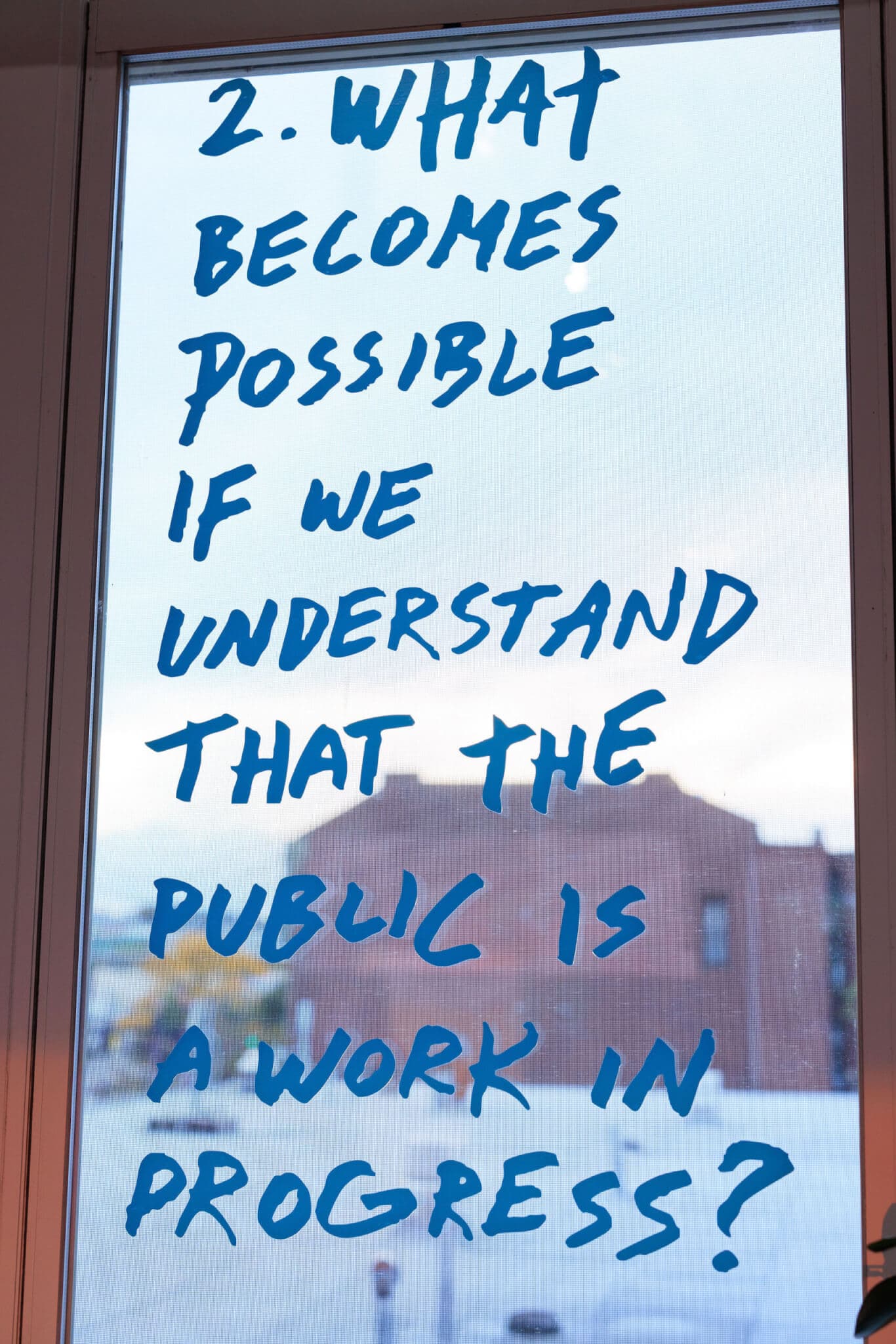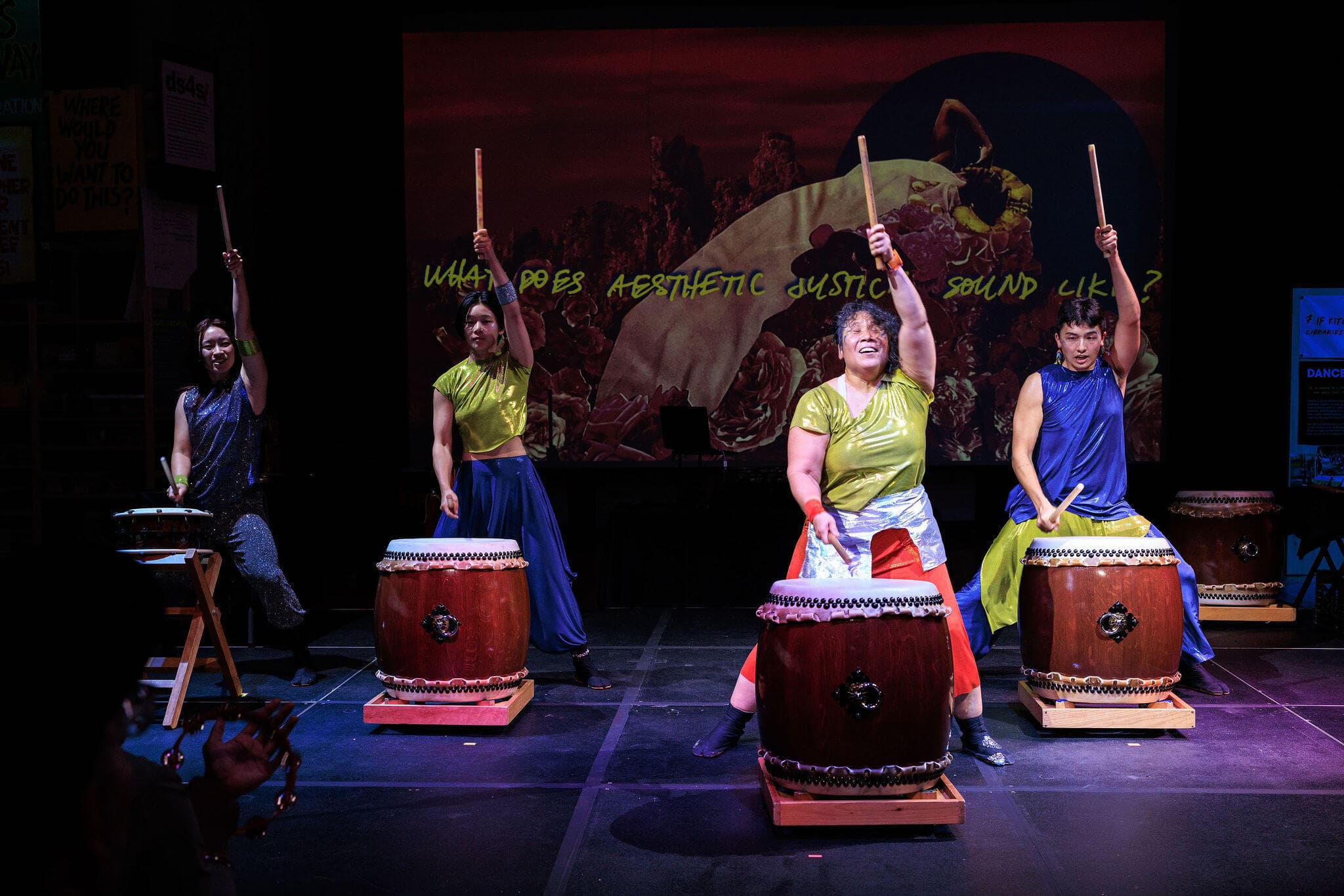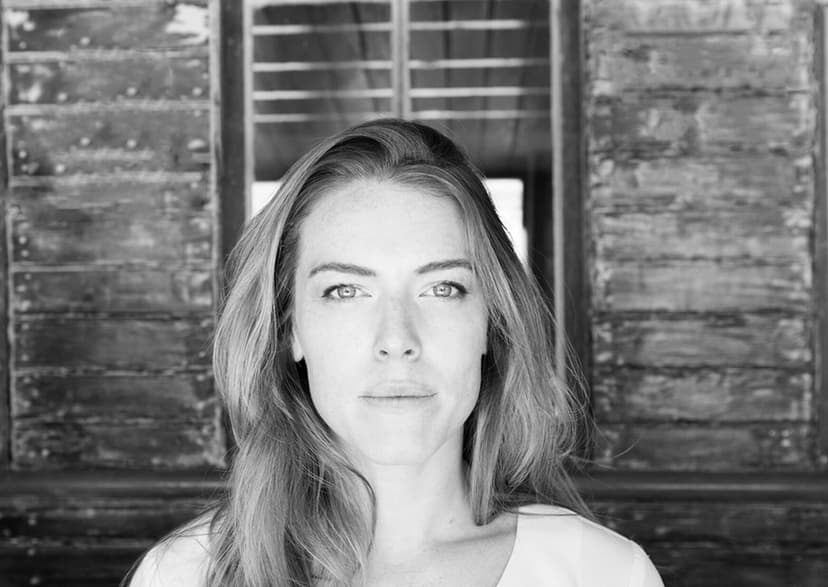This year, the Design Studio for Social Intervention celebrates twenty years of bringing inventive trickster-inspired design thinking to civic engagement by combining artist strategies with community activism.
To celebrate, the organization has set up a temporary hub on the third floor of Hibernian Hall, in Roxbury, to invite the public to join them in a month of public programming intended to facilitate communal thinking, open-ended study, and engagement with the organization’s history of publications, provocations, and events. Titled 20 Questions for 20 Years, the program uses a list of questions to give shape and offer visitors an entry point to DS4SI’s work.
Primarily known for their community cultural space, the Design Gym, DS4SI’s work rises out of the decline of non-commercially driven places where community is formed and articulated outside of work and home, or what sociologist Ray Oldenburg called “third spaces.” The shuttering of public spaces for communities to build and articulate shared social values has been significant in the US in recent decades, particularly for folks from under-invested in or otherwise marginalized neighborhoods. DS4SI proposes that these third spaces can be not just physical places but also skills, strategies, and ideas that anyone with an interest in community development can develop and deploy.
The studio’s work draws on other notable figures working at the intersection of art, aesthetics, and civic life including Augusto Boal, who is known for Theatre of the Oppressed, a framework that uses interactive theater techniques to incite social and political change; Bogotá mayor and artist Antanas Mockus, who implements civic interventions like swapping clowns for traffic cops; and most directly, Brazilian artist Claudio Padro. With their project The People’s Late Night, DS4SI created a local interpretation of Padro’s work that applies the late night interview television show format to local neighborhoods. Like Padro, they sought to platform friends’ and neighbors’ views in the way that celebrities’ and politicians’ views are platformed to symbolically give them the same level of attention currency.
DS4SI’s free-wielding range of social practice projects includes their book, Ideas, Arrangements, Effects (2020), community engagement projects, and placemaking work. Among these initiatives, notable DS4SI projects include the Dance Court, a temporary mobile dance floor social sculpture that invites attendees to consider what it might look or feel like if public infrastructure included spaces for dancing in the same way it does for sports courts. Their 2014 project Light up the Bridge transformed an underpass into a light art installation, while their more recent 2020 project Social Emergency Response Center, was created as a format for mediated community participation theater that helps people metabolize the complexity of the moment on any given day.
Beyond their commitment to bringing people together locally, DS4SI has collaborated with several artists who operate in international circles including Tania Bruguera, Nick Cave, Bruce Cayonne, Christopher Cozier, Tiago Gualberto, and Intelligent Mischief. For the twentieth-anniversary closing weekend, they will be joined by artists Grisha Coleman and Thomas DeFrantz as well as curator Nato Thompson.
Ahead of the last weekend of their anniversary festival of community lunches, workshops, and artist talks, I sat down with DS4SI co-founders Kenneth Bailey and Lori Lobenstine, and ecologies of thought lead, Judith Leeman, to talk about the studio, their work, and how their methods can empower people to respond to today’s cultural-political moment.
Every production has a behind-the-scenes center of operations that is part office, part storage, part chaos triage. There, on a sofa between boxes and under a sign taped to the wall reading “This is a chill space,” the DS4SI leaders took turns sharing their thoughts on the project with me while also greeting a revolving door of collaborators, community members, and well-wishers.
This interview has been edited for length and clarity.

(left) DS4SI co-founders Lori Lobenstine and Kenneth Bailey. (right) Ecologies of thought lead, Judith Leeman, giving a talk at the DS4SI 20 Questions for 20 years event. Photo by Obinna Ojimba. Courtesy of DS4SI.
Kim Córdova: Well, so maybe we just start at the beginning. Can you tell me a little bit about your origin story and the origin of DS4SI?
Kenneth Bailey: So in 2003, I got a residency at MIT at the Center for Reflective Community Practice. It was with their community fellows program. Through that we got space and access to academics, the facilities, and thinking at MIT for a year, which wound up being two years. And in that [fellowship], I was asking questions about imagination and social change. Like why don’t we have more space for continuing to invent methodologies, continuing to think imaginatively as a kind of technology, the way we do around planning and evaluation in the social justice sector? Rob Pegler, who was also in that same residency, said, “Oh, what you’re talking about is design thinking. And what you’re interested in is design as a set of techniques and methodology.”
I was coming out of organizing and social justice, and Rob was coming from design and a more art-adjacent world. We said, “Let’s create something together.” It just so happened that we both were reading Trickster Makes This World.
Judith Leeman: It’s a cool book about the role of the trickster as an archetype for thinking about social structures and social change and social stagnation. Where change comes from, how change happens, and how that [process of creating change] is different than what people think.
KB: So it was at MIT that I sort of learned about design as a place for cross-disciplinary thinking, like bringing dancers or people working in literature or in other forms of intelligences together with people who are primarily working in shifting power and policy. When you bring those ways of thinking together, you can potentially synthesize new insights that can lead to new outcomes or new experiments. And one of the things we were interested in doing is creating a way to make that case, because it wasn’t a case yet. And twenty years ago, we figured that if we were to make [that case] we needed to actually put organizational weight behind it and decided to start an organization and make it happen. That’s how we became DS4SI.
KC: So how did it formally start?
KB: I got two small grants, one from Ford and one from New World Foundation.
KC: Wow, those are big-name foundations. Did those grants really help DS4SI institutionalize as a new organization?
KB: They were small amounts from big names, which then created the catalyst. And yes, we decided to go with the fiscal sponsor Third Sector New England and go the nonprofit route.
KC: It seems like your growth since then has been pretty exponential. What were the catalytic moments for the studio?
KB: It’s a good question. The moment in time was definitely post-COVID and post-BLM. It was definitely the kind of bump that happened with a lot of Black and BIPOC leadership, people were like, “Yeah, maybe we should invest more in this world.”
JL: At the beginning, well, basically the beginning because this was 2007 and DS4SI started in 2005, the Berwick Research Institute was hosting these dinners which were a precursor to a lot of non-monument-based, public art-making that we are seeing all around us now. Berwick was the first incubator of that. And they hosted these dinners and I sat down next to a man [motions to Kenny] who started talking about systems change and second-order change. I was a materials-based artist who had just come from Chicago and was finishing grad school.
KB: You had just moved from Chicago?
JL: Yes, two years before. I moved in 2005.
KC: It sounds like the universe was clearly bringing you together if you moved to Boston the same year that DS4SI started.
JL: Yeah. So at the dinner I realized that I, as an artist who had been doing secret reading and systems thinking, had found a person and an organization with whom the way I was thinking formally had a place to play. At the time, the language that you guys [DS4SI] were using was that the civil society sector was in a crisis of imagination.
KB: That’s right!
JL: And that your sense was that artists had certain kinds of permissions that didn’t exist in the sector.
KB: That’s right!
JL: Yeah, I have a good memory! And that they [DS4SI] were interested in figuring out what it looks like to think with artists early in a process, not just to bring artists in at the end to illustrate something that was being figured out.
KB: Because we were interested in sort of the way in which artists get to approach thinking as much as we were interested in the actual thought. You know, a lot of artists would definitely say we were romanticizing artists.
JL: I never said it out loud.
KB: I get it, but I think it was just a shorthand. I knew that we would have to find more precise language. What I was interested in is the procedures and permissions toward a kind of sense-making that I wasn’t seeing readily intelligible inside of the larger social justice sector at the time.
JL: And valuing the distance between artist and activist as different practices. We were experimenting with what happens if the artist doesn’t try to collapse their practice into being an activist and the activist doesn’t collapse their practice into being an artist.
If we both would look at something, your organizer eyes and my artist eyes would see something and we could overlay them [our different perspectives] and understand something about the patterning of that thing in a way that hadn’t been possible when you’re in just one discipline. The studio brings activists and artists and academics together with the idea that the really sticky problems are kept in place partly by the way we think in ruts, the way we think in the grooves of our disciplines.
KB: And that we needed an actual space to try to think across disciplinary boundaries. But even more so than just disciplinary boundaries, it was across sort of life worlds.
JL: Epistemologies
KB: Yeah, the life world of the artist, the life world of the actor.
JL: The sensibility.
KC: Flashing forward, can you walk me through what DS4SI is doing now? How has your model changed or evolved?
KB: The studio says that everyday life is pretty boring and lacks a lot of sensibility, particularly here in New England. And that part of our approach to social justice is about making life vibrant and interesting.
JL: And that justice isn’t enough; vibrancy is needed too. That the argument saying, “We want a just world” misses the actual call. And we want a vibrant world.

Installation views depicting questions 2 and 18 from DS4SI’s “20 Questions For 20 Years.” Photo by Obinna Ojimba. Courtesy of DS4SI.
KB: Both are true. A vibrant, aesthetically diverse, interesting life is worth fighting for. And in order for us to produce the kind of lives we want, we have to get in the business of producing everyday life. We have to get in the business of producing our social aesthetic and not just being in response to that which already exists or to the kind of aesthetic sensibilities that are projected outward. And we have to develop a kind of aesthetic and critical literacy and politicize the aesthetic situation that we find ourselves in at the level of sight, sound, taste, smell, in order to feel like we can have agency inside of it and not just be relegated to it.
So I guess out of that, we have a critique of everyday life. We think that everyday life—nationally and particularly the one that’s being moved forward right now—is becoming blander and blander and tighter and tighter.
JL: Can I jump in with one thing? One of the things the studio has consistently done is to take seriously the last question in our twenty questions: “How do we reimagine imagination?”
So there is also a pushing back against the idea that imagination is separate from close study of the current conditions we’re in. Through things like the ideas, arrangements, effects framework, through close reading workshops, through collective study, we’re consistently bringing people together to look at the material conditions of our lives and the formal arrangements of those conditions in a way that lets something else be imagined, not as kind of flight of fantasy, but as a real pivot from what those conditions are. And so a lot of the tools, or protocols, that we develop are to help people make that pivot. To help them not divorce close attention from desire and prototyping, testing out versions of what we might want, what we might prefer or want to see.
KC: How do the frameworks and methodologies that you’re offering help folks grapple with or otherwise make our way through this time?
KB: I’ve been thinking a lot about sentiment. I feel like we’re at a place to actually tackle culture at the structure of sentiment. And that one of the culture wars we’re in right now is a war around sentiment. We have to produce a sentiment that actually is open to difference. Versus this sentiment that’s about enclosure and increasing silos.
We have to get into the culture war and produce or sort of propagate a sentimentality that is aligned with respective differences. And we have to get really good at it and we have to get really bold with it. And I feel like right now we’re retreating because the excess of the sentimental project of bullying and the sentimental project of avarice that’s being led right now in the country is taking up so much space that I feel like those of us who care about public atmosphere, who care about sentiment, are retreating. But I feel like we have to get in the business of actually producing a sentimentality, producing sentimentalities of worlds, of worlds we want. And not just allowing the theater of fascism and its propagandas and its public performance to completely consume everything.
LL: I would add that I feel like in any moment that feels high risk, we tend to revert back to familiar ways of being. So I think that what we are really interested in thinking about right now is how do we resist that? How do we expand our range of motion? How do we work with folks we haven’t worked with before? How do we try things that we haven’t tried before? How do we take risks at a time where it feels for many people that just existing is risky or stepping out of the ordinary is risky.
I think it’s one of the things that people really appreciate about the spaces we create. We hear them say, “I see folks at the design gym that I don’t see anywhere else” or “I hear conversations that I don’t hear in other places.” I think that in this moment, it is really important to think about how we are going to learn new skills or try new ways of being if we keep talking to the same folks or doing the same thing.
KC: The event is called 20 Questions for 20 Years, and you’ve interspersed the questions throughout the city on posters and bus station ads. How have you envisioned that the twenty questions shape the event and public participation in it?
LL: I don’t know if the questions shape the event, but they weave in and out of the event. The questions themselves are an intervention. We try to actually put them up around the city as an intervention, as a provocation, as a way to invite people into some of the questions, like “What is a citizen forbidden from feeling?” or “What is hidden in public?” or “How do we reimagine imagination?” They are questions that we wanted to share in public space with passersby. So folks might look for the questions or they just might stumble upon a question. And then there are questions that we were really using to highlight some of our work, like “Have you framed the problem large enough to include yourself?” which was really part of how we were thinking about our Social Emergency Response Center. But there are a lot of ways that we let the questions weave throughout the space. Like there are questions on the windows that you might look out and see—like “What’s happened to us spatially?”—while you’re looking out at the city. So they’re not really like the format per se; they operate sort of as a subtext.

KASA Taiko’s performance at the DS4SI twentieth-anniversary celebration kickoff. Photo by Obinna Ojimba. Courtesy of DS4SI.
KC: Coming up on the final weekend, which moments in the program are you particularly looking forward to?
LL: We have two curators this weekend: Nato Thompson, who’s leading the theme Intervening in the Moment, and Grisha Coleman, who’s leading the theme of Rehearsing and Performing the Everyday. Grisha has choreographed this incredible spectacle at Mary Hannon Park, which will include dancers. I’m really excited for that and her mass somatic event the next day in the hub, which is our closeout day.
I’m also interested in Nato and the way he’s woven together some really different folks from social practice to engage with social intervention in this moment. And he is also thinking about how we bring our work together with No Kings days.
I’m also really excited for our Friday Night Life, which is a theme we’ve had for a couple of years that involves activating spaces and asking people to imagine what they would like to see more of in Boston. Kenny’s going to be DJ’ing and we’re having an intervention by [artist] Pedro Reyes, Singagram, at the same event. So like this is just how we roll. Like mix things together in ways that I think can really blend together the familiar and the strange.
KC: Thinking about that familiar and the strange, how are you thinking about this kind of culminating twenty-year moment? Do you feel that it is like either picking up the threads of or reflective of or maybe an evolution of the early years of DS4SI?
LL: That’s a hard question. I feel like it’s gonna take me a while to really sit with all of the things that I’ve been taking in over the weekends. I’ve really enjoyed both the activation of the space, the way people have jumped into the social-making, jumped into the Urban Drawing Corps, seeing [people] drawing things that are happening in the space is such a beautiful reflection.
The witnessing that Judith has helped curate and the inviting of artists who we really respect to witness and play back for us some of the things that are resonating with them. Diving into the archive with our co-founders and our youth organizers and all the different ways that we’ve been learning over the past month I think will continue to really help us think about what is resonating and sort of continuing in the world. One of the things that Lisa Jarrett said at the Sara Hendren and Garnette Cadogan talk last Sunday was that one measure of success for her is when things carry on without her. And that really struck me.





